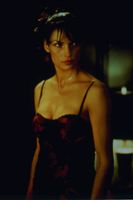
HOUSE ON HAUNTED HILL
Distributed by Independent Films Holland

|
Boo! This slickly drawn attempt at creating a "good-old-fashioned-horror-film" fails in
quite a different way than the original version with Vincent Price. The black-and-
white 1958 version possessed a certain charm in its naive attempt (à la William
Castle) to thrill viewers with the mysterious, yet devious, goings-on in the cardboard
castle. His creaking door had the added attraction of (figuratively) nailing viewers to
their seats as they anxiously sat through the only film to be made in "Emergo" (which
turned out to be nothing more than a flimsy, lit-up, purple-and-white paper skeleton
moving on a draw string at the upper right hand corner of the screen). This time
around, one can thrill to the CGI FX beast that (for no acceptably logical reason)
astonishingly fills the hallways near the end of a similar tale, which, in this day and
age, no longer possesses anything approaching naiveté or charm. The
disappointment is even greater after having watched the initial parade of limousines
approaching the curved path toward the castle, which nostalgically brings back
memories of the earlier film. This opening sequence manages to create a burst of
anticipation, leading one to believe that the cinematic innocence of earlier days might
be recaptured and possibly even improved upon in the reworking of a hi-tech age.
Oh, false anticipation and ghost of a bygone age. Boo, boo, boo!
Terrible things were done to the patients inside the walls of the Vannacutt Psychiatric
Institute for the Criminally Insane (not a particularly politically correct name for a
mental health farm). Torture, experimentation, and all sorts of depraved antics were
taking place here in its heyday, but, yeah, all good things must come to an end.
Now, some decades later, a party is about to take place and the five invitees have
been offered a million dollars each if they manage to spend the entire night there
(alive). (Just to show you how times have changed: In the original film the guests
were only offered ten thousand dollars. Life is cheap, but not as cheap as it used to
be.)
Steven Price (Geoffrey Rush) has made his fortune in theme parks and what better
treat could he have in store for his lovely wife Evelyn (Femke Janssen) than throwing
her a birthday party in this macabre surrounding. The guests who have arrived,
however, are not the ones invited. No, they're not gate crashers out for a demented
thrill, but only greedy strangers. There seems to have been a mistake made in
addressing the invitations and both Steven and Evelyn (whose mutual love is long
lost) suspect one another for this unfortunate mix-up. Hell, these strangers couldn't
care less; they're just in it for the money. In the spirit of a promise is a promise,
Steven proceeds with the evening and accepts the five unknown visitors as bait for
the proceedings. The house is rigged with frightening devices, designed to scare the
wits out of any witless person. Once the feast begins, the building comes alive with
worse supernatural activity than found in the remake of "The Haunting." A person
gone is a penny earned.
HOUSE ON HAUNTED HILL
Distributed by Independent Films Holland

|
Once the lockdown mechanism of the building shuts itself automatically, it looks as if
the option of leaving the premises has quickly disappeared. The five money-hungry
sods making the best of a "bad" situation while trapped between the walls for the
witching hour are Watson Pritchett (Chris Kattan), Sara Wolf (Ali Larter), Melissa
Marr (Bridgette Wilson), Dr. Blackburn (Peter Gallagher), and Eddie (Taye Diggs).
Nobody trusts each other, which always makes for an interesting party mix.
As far as the cast is concerned: Rush may be many things, but Vincent Price he
ain't. It's nice to see Femke Janssen strutting her stuff in a sizeable roll. What was
Peter Gallagher thinking when he decided to do this?
There is, nevertheless, among the entourage of visual freakies, an interesting dream
sequence that reverberates reminiscently with images similar to the black and white
"Cabinet of Caligari (1962)," a low budget remake of "Caligari" (which, although
fascinating, bears little resemblance to its esteemed predecessor from 1920). Add a
touch of "Rosemary's Baby" to the film and you're set to go. (Of course, you can't,
because the doors are locked.)
Producers Robert Zemeckis and Joel Silver might have done better to choose
another script for the first movie made under the auspices of their new production
company Dark Castle. Screenwriter Dick Beebe and director William Malone
developed the screenplay alongside them. They seem to have gotten so carried
away with what modern technology can do that they lost sight of what they were
doing.
© 1994-2006 The Green Hartnett
|

